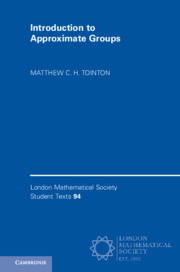Book contents
- Frontmatter
- Dedication
- Contents
- Preface
- 1 Introduction
- 2 Basic Concepts
- 3 Coset Progressions and Bohr Sets
- 4 Small Doubling in Abelian Groups
- 5 Nilpotent Groups, Commutators and Nilprogressions
- 6 Nilpotent Approximate Groups
- 7 Arbitrary Approximate Groups
- 8 Residually Nilpotent Approximate Groups
- 9 Soluble Approximate Subgroups of GLn(C)
- 10 Arbitrary Approximate Subgroups of GLn(C)
- 11 Applications to Growth in Groups
- References
- Index
10 - Arbitrary Approximate Subgroups of GLn(C)
Published online by Cambridge University Press: 31 October 2019
- Frontmatter
- Dedication
- Contents
- Preface
- 1 Introduction
- 2 Basic Concepts
- 3 Coset Progressions and Bohr Sets
- 4 Small Doubling in Abelian Groups
- 5 Nilpotent Groups, Commutators and Nilprogressions
- 6 Nilpotent Approximate Groups
- 7 Arbitrary Approximate Groups
- 8 Residually Nilpotent Approximate Groups
- 9 Soluble Approximate Subgroups of GLn(C)
- 10 Arbitrary Approximate Subgroups of GLn(C)
- 11 Applications to Growth in Groups
- References
- Index
Summary
We present Breuillard, Green and Tao’s theorem that a finite approximate subgroup of a complex linear group of bounded degree is contained in a union of a few cosets of a nilpotent subgroup of bounded step. We state two substantial ingredients without proof. The first is a result of Mal’cev and Platinov that a virtually soluble complex linear group of bounded degree has a soluble subgroup of bounded index. The second is Breuillard’s uniform Tits alternative, which states that if a finitely generated complex linear group of bounded degree is not virtually soluble then there exist two free generators of a free subgroup that can be expressed as products of boundedly many generators. The third main ingredient is a result, due independently to Sanders and to Croot and Sisask, that if A is an arbitrary approximate group then there is a relatively large neighbourhood of the identity S with the property that a large power of S is contained in a small power of A; we prove this in full.
Information
- Type
- Chapter
- Information
- Introduction to Approximate Groups , pp. 170 - 177Publisher: Cambridge University PressPrint publication year: 2019
